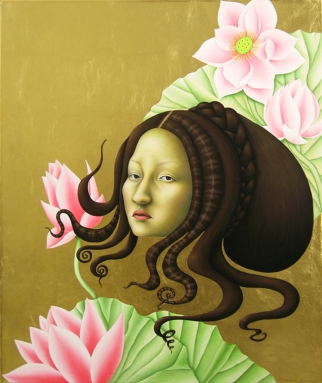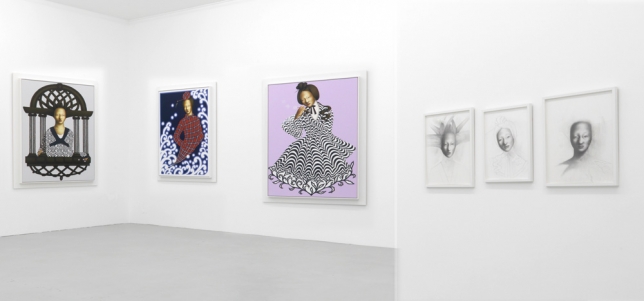01.09. – 20.10.07
Aya Uekawa
“Second World Complex”
Solo exhibition at Arndt & Partner, Berlin
Aya Uekawa
Born 1979, Tokyo, Japan
Lives and works in New York, USA
Lost in thought, inaccessible, defiant yet vulnerable, the young women populating the visual world of Japanese-American artist Aya Uekawa (born 1979 in Tokyo), appear to be waiting for something we remain oblivious to. The features of Uekawa’s mysterious, slightly disturbing female figures invoke elements of medieval altarpieces, renaissance effigies and Japanese manga. Their clothing and settings however, are clearly inspired by op and pop art – an unusual and at first glance, perhaps awkward conflation. This tension gives Uekawa’s paintings their characteristic lure and distinct style and underscores her contribution to contemporary figurative painting. Oscillating between trompe-l’oeil and op art effects, her paintings draw the observer’s gaze into an abundance of detail. The viewer is immersed in serene, enigmatic narratives, with a magic founded on ambivalence.
Uekawa’s images are characterized by mysterious, disquieting and muted places – daydream spaces in which time appears to stand still. We are presented with a strange world – familiar, yet at the same time surreal. But what of the girls and women portrayed in her work? The focal point of her images, they are no less ambiguous than their surroundings. Their delicate features, lightly distended eyes or lips, and braided hair invoke a bygone era. At the same time they appear fashionable, even artificial. Absorbed by their private worlds and seemingly displaced from their environments, the subtlety of their facial expressions prevents precise readings of their emotions. Their highly idiosyncratic features combine with modern yet somehow timeless clothes so that the viewer is unable to discern clear cultural or ethnic signifiers. Perhaps the clothing is a fashionable shield, a foil that draws attention away from their wearer by cloaking them in regular geometric patterns?
Or perhaps they are an expression of a new identity, one that does not completely match their face? A further aspect of such ambiguities in Uekawa’s practice is evidenced in Chrysanthemum Syndrome (2006): it is difficult to determine what the plants that appear in all of her portraits and that occasionally seem to develop an independent life are intended to signify. Should the chrysanthemum be read here
as the national flower of Japan, threatening to smother the subject of the painting? Or is the flower a symbol of immortality and perfection, successfully cultivated by the subject to ward off evil? Aya Uekawa’s visual landscapes invite the viewer to make connections between disparate stylistic elements combined with a collage-like sensibility. Their meaning is revealed through an active process of interpretation. In this way, the works of the New York based painter facilitate a brief moment of recognition – a glimpse into the emotional world of a generation characterized by conflicting sensations like no other before it. Emerging from a tradition of individual portraiture in which the representation of social issues was always as inherent to the work as physiognomic likeness, Uekawa creates images that are rich synonyms for the cleft between Japanese tradition and western life. At the same time they are exemplary instances of the quintessential consciousness of a young generation of global individuals in
search of their own identity and happiness at the outset of the 21st century.
TEXT TANJA Vonseeln
CV
Aya Uekawa was born in Tokyo, 1979. She studied at Komazawa University, Tokyo, and at Hunter College, New York. She lives and works in New York. Following numerous exhibition participations in Japan and the United States, she presented her first solo show at the Kravets|Wehby Gallery in New York in 2006. Selected Exhibitions are "Three-persons Exhibition" at Baltimore Museum of Art (Participating artists are Sascha Braunig,Erik Thor Sandberg, and Aya Uekawa) (2013), "Going International" at FLAG Art Foundation, New York (2010) and "Sanctuary Dreams," at Contemporary Arts Center, Cincinnati, Ohio (2009).
Arndt & Partner Berlin schowcased the young artist’s work to the German public for the first time in 2007.
EXHIBITIONS:
01.02 - 12.03. 2010
“A Long Way From Home”
Group exhibition with works by Jitish Kallat, Vik Muniz, Koshrow Hassanzadeh, Aya Uekawa, Wang Du, Jonathan Hernández, Jules de Balincourt, (Arndt & Partner, Berlin, Halle am Wasser)
01.09. – 20.10.07
Aya Uekawa
“Second World Complex”
Solo exhibition at Arndt & Partner, Berlin
 Aya Uekawa, Mimic Dream, 2011, acrylic and 24k Japanese gold leaf on canvas stretched over wood panel, 72,39 x 71,12 cm | 28.5 x 28 in
Aya Uekawa, Mimic Dream, 2011, acrylic and 24k Japanese gold leaf on canvas stretched over wood panel, 72,39 x 71,12 cm | 28.5 x 28 in Exhibitions
PRESS RELEASE
Lost in thought, inaccessible, defiant yet vulnerable, the young women populating the visual world of Japanese-American artist Aya Uekawa (born 1979 in Tokyo), appear to be waiting for something we remain oblivious to. The features of Uekawa's mysterious, slightly disturbing female figures invoke elements of medieval altarpieces, renaissance effigies and Japanese manga. Their clothing and settings however, are clearly inspired by op and pop art - an unusual and at first glance, perhaps awkward conflation. This tension gives Uekawa's paintings their characteristic lure and distinct style and underscores her contribution to contemporary figurative painting. Oscillating between trompe-l'œil and op art effects, her paintings draw the observer's gaze into an abundance of detail. The viewer is immersed in serene, enigmatic narratives, with a magic founded on ambivalence.
Uekawa's images are characterized by mysterious, disquieting and muted places - daydream spaces in which time appears to stand still. We are presented with a strange world - familiar, yet at the same time surreal. But what of the girls and women portrayed in her work? The focal point of her images, they are no less ambiguous than their surrounds. Their delicate features, lightly distended eyes or lips, and braided hair invoke a bygone era. At the same time they appear fashionable, even artificial. Absorbed by their private worlds and seemingly displaced from their environments, the subtlety of their facial expressions prevents precise readings of their emotions. Their highly idiosyncratic features combine with modern yet somehow timeless clothes so that the viewer is unable to discern clear cultural or ethnic signifiers. Perhaps the clothing is a fashionable shield, a foil that draws attention away from their wearer by cloaking them in regular geometric patterns? Or perhaps they are an expression of a new identity, one that does not completely match their face? A further aspect of such ambiguities in Uekawa's practice is evidenced in "Chrysanthemum Syndrome" (2006): it is difficult to determine what the plants that appear in all of her portraits and that occasionally seem to develop an independent life are intended to signify. Should the chrysanthemum be read here as the national flower of Japan, threatening to smother the subject of the painting? Or is the flower a symbol of immortality and perfection, successfully cultivated by the subject to ward off evil?
Aya Uekawa's visual landscapes invite the viewer to make connections between disparate stylistic elements combined with a collage-like sensibility. Their meaning is revealed through an active process of interpretation. In this way, the works of the New York based painter facilitate a brief moment of recognition - a glimpse into the emotional world of a generation characterized by conflicting sensations like no other before it. Emerging from a tradition of individual portraiture in which the representation of social issues was always as inherent to the work as physiognomic likeness, Uekawa creates images that are rich synonyms for the cleft between Japanese tradition and western life. At the same time they are exemplary instances of the quintessential consciousness of a young generation of global individuals in search of their own identity and happiness at the outset of the 21st century.
